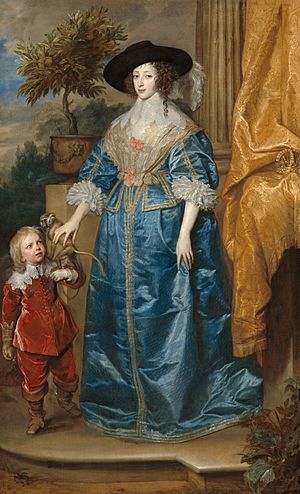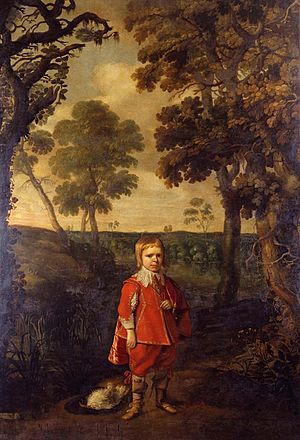Jeffrey Hudson facts for kids

Jeffrey Hudson (1619 – around 1682) was a very small person who worked in the royal court of the English queen Henrietta Maria of France. He was known as the "Queen's dwarf" and "Lord Minimus." People thought he was amazing because he was extremely small but perfectly formed. He fought for the Royalists during the English Civil War. He later went with the Queen to France. However, he was sent away from her court after he killed a man in a duel. Jeffrey was then captured by Barbary pirates and forced to be a slave in North Africa for 25 years. Eventually, he was bought back to England.
Contents
Jeffrey Hudson's Early Life
Jeffrey Hudson was born in Oakham, Rutland, on June 14, 1619. His parents, three brothers, and a half-sister were all of regular height. Jeffrey's father, John, worked for George Villiers, the Duke of Buckingham. Jeffrey's amazing small size and normal body shape were clear from when he was very young. People had different ideas about why he was so small. It's now thought he likely had a problem with his pituitary gland, which affected his growth.
In 1626, Jeffrey Hudson was shown to the Duchess of Buckingham as a "special wonder of nature." She invited him to live with her family. A few months later, the Duke and Duchess hosted King Charles I and his young French wife, Queen Henrietta Maria, in London. The most exciting part of their grand dinner was when Jeffrey was presented to the Queen. He was served in a large pie! When the pie was placed in front of the Queen, Jeffrey popped out. He was only 18 inches (46 cm) tall and wore a tiny suit of armor. The Queen was very happy, and the Duke and Duchess of Buckingham gave Jeffrey to her as a fun gift.
Life at the Queen's Court

Jeffrey Hudson moved into Denmark House in London in late 1626. This was where the Queen lived with her many French helpers and Catholic priests. He was one of several interesting things and pets at court. These included a very tall Welsh porter named William Evans, two unusually shaped dwarves, and a monkey named Pug. Jeffrey later had a funny act with William Evans. The porter would pull Jeffrey out of his pocket along with a loaf of bread, then pretend to make a sandwich. As Jeffrey grew up, he learned to entertain people with his cleverness and polite manners, not just his size.
Small people were not rare in European royal courts. However, Jeffrey's perfect body shape and tiny size made him uniquely famous. His height was often described as 18 or 19 inches. He reportedly grew very little between the ages of 7 and 30. He often played fun roles in the fancy costumed plays called masques. These plays were put on by Inigo Jones to entertain the court.
Jeffrey rode horses with the Queen and her household. Ten ladies and three laundry maids had special Sidesaddles. Jeffrey, the "dwarf," had a fancy velvet saddle with silver and silk decorations. The court tailor, Gilbert Morrett, made clothes for Jeffrey. He had an "ash color suit" and a "black mourning suit." He also had scarlet red stockings to wear under his armor. The Queen's tailor, George Gillin, made clothes for another small person named Sarah, or "little Sara." Jeffrey and Sarah wore clothes made from the same fabrics as Queen Henrietta Maria's own children. In 1627, Daniel Mytens was paid £40 to paint Jeffrey's portrait, showing him "in a wood or wilderness."
In 1630, when he was about 10 years old, Jeffrey was part of a trip to France. The main reason for the trip was to bring back a midwife for the Queen's first pregnancy. But it's likely Jeffrey was sent to entertain the French court. On the way back across the English Channel, their ship was captured by Dunkirk pirates. The pirates robbed the ship but eventually let them go back to England. Jeffrey's second trip across the Channel was in 1637, when he was 18. A group of courtiers traveled to the Netherlands to watch the siege of Breda. This was when the Dutch army was trying to force out the Spanish army.
Jeffrey was educated in the Queen's household and learned how to behave at court. He was raised in the Roman Catholic Church, like the Queen's family. He learned to ride a horse and shoot a pistol. Many poems and stories of the time celebrated him. But even though he was clever and smart, his small height was what people valued most. Everyone knew that if he had been of normal height, he would not have had a place at court. This was even mentioned in some of the poems written about him.
The English Civil War and Life in Exile
By 1640, the relationship between King Charles and the Parliament had become very bad. There were plots and attempts to arrest people. In 1642, fighting broke out between the Royalists (who supported the King) and the Parliamentarians (who supported Parliament). As King Charles led the Royalist army, the Queen took a small group of her staff, including Jeffrey, to the Netherlands. She wanted to raise money and support for the King. By selling items from her palace, she raised enough money to buy some supplies for the Royalist army. However, she could not get official support from the Dutch government. She returned to England with her courtiers and found herself in the middle of a civil war.
They were able to join the Royalist forces in Oxford. The Queen made Jeffrey a "Captain of Horse." We don't know if he led troops or fought in any battles. But he considered this title a great honor, not a joke. Later in life, he continued to call himself "Captain Jeffery Hudson."
As it became clear that the war was getting bigger, the Queen fled to France in 1643. A small group of courtiers and household staff, including Jeffrey, went with her. They were welcomed warmly in France and given space in the Louvre Palace. However, the Queen was not well after a difficult birth. She soon moved her court in exile to a spa town called Nevers.
Duel and Its Consequences
Royalist courtiers gathered around the Queen. But Jeffrey apparently did not want to go back to being a pet or a clown. He made it known that he would not put up with any more jokes or insults. We don't know exactly what offense was given. But in October 1644, Jeffrey challenged the brother of William Crofts to a duel. Crofts arrived at the duel holding a large water squirt gun. His playful attitude led to his death, as Jeffrey fatally shot him in the forehead.
Crofts's death was a disaster for Jeffrey. Duelling was against the law in France. This act could be seen as a disrespect to their hosts. Also, William Crofts was an important person. He was the Queen's Master of the Horse and head of her bodyguards. Jeffrey was first sentenced to death. But Queen Henrietta Maria stepped in to save his life. He was then sent back to England.
Slavery and Later Life
We don't know much about Jeffrey Hudson's movements after he left the Queen's court in late 1644, when he was 25 years old. Within months, he was on a ship that was captured by Barbary pirates. Jeffrey was taken to North Africa as a slave. He spent perhaps the next 25 years working there. We don't know the exact date or how he was rescued. But in the 1660s, several missions were sent from England to Algeria and Tunis to buy back English prisoners. Jeffrey's first recorded appearance back in England was in 1669. No details of his time as a slave were written down, except one thing: he claimed to have grown to 45 inches (114 cm) during this time. This meant he doubled his height after the age of 30.
The few records of Jeffrey Hudson's years between 1669 and his death in 1682 are mostly receipts for money given to him by the Duke of Buckingham and the new King. He did not return to the Queen's court, even after the royal family was brought back to power in England in 1660. The Queen herself returned at the invitation of her son, Charles II. She lived in London for only five years, then fled to France during the London plague of 1665. She died in France in 1669, the same year Jeffrey first appeared in English records again.
Jeffrey lived in Oakham for several years. There, he was interviewed by James Wright, a person who studied old things. Wright wrote a short record of Jeffrey's life. In 1676, Jeffrey returned to London. He might have been trying to get a pension (regular payment) from the royal court. He arrived at a difficult time when there was a lot of anti-Catholic feeling. This included the "Popish Plot" started by Titus Oates. Jeffrey was imprisoned "for a considerable time" at the Gatehouse Prison. Being a "Roman Catholick" was the only reason recorded for his imprisonment. He was not released until 1680. He died about two years later, around 1682. The exact date and circumstances of his death are unknown. He was buried in an unmarked grave for poor Catholics. A payment from King Charles II in 1681 is the last record of Jeffrey Hudson.
|
See also
- List of slaves
- Richard Gibson (painter) – another small person at the Stuart court

